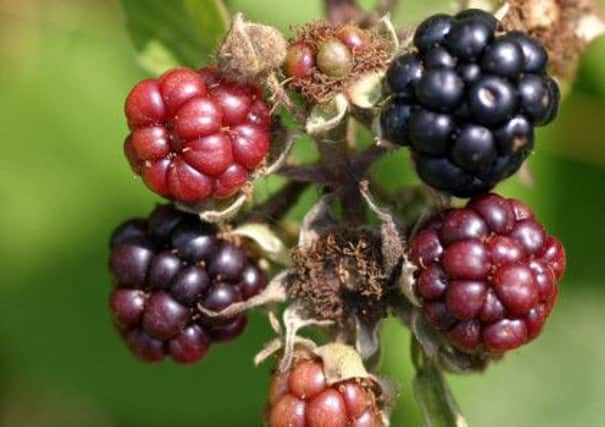Bonanza of berries welcomes autumn


It seems that the never-ending winter and unfeasibly cold spring earlier in the year may have actually proved a blessing for our beleaguered fruiting trees and bushes.
Autumn is now expected to be late and, according to the Woodland Trust who monitor the changing seasons through their Nature’s Calendar project, when it does finally arrive, it’s predicted to produce a berry bonanza. Hedgerows, woodland edges, parks and gardens should be laden down with plump clusters of blackberries, sloes, elder berries and sweet chestnuts.
Advertisement
Hide AdAdvertisement
Hide AdNature’s Calendar project manager Dr Kate Lewthwaite explains: “So far we have only had a few sightings of the autumn berries from bramble, rowan and blackthorn. This along with the delayed onset of spring flowering suggests that autumn fruiting will be late this year.
“Autumn fruiting dates vary considerably from year to year as they are affected by temperature and rainfall. If last month’s warm weather interspersed with occasional wet spells continues, the fruiting of autumn shrubs should be abundant.
“The relatively late flowering may have helped avoid any frost damage to flowers, and thus help fruiting. With July 2013 being the third warmest since 1910 and August temperatures being about average with a fair amount of rainfall, we predict a good fruiting crop this autumn.”
For the majority of us, autumn foraging consists of scrabbling around in the local bramble patch for blackberries. These encounters typically confirm a universal truth that the plumpest, juiciest berries are always tantalisingly just out of arm’s reach.
Advertisement
Hide AdAdvertisement
Hide AdThe humble blackberry is more mysterious than we give it credit for with around 400 subspecies, all of varying taste, size and fruiting period. Experts say berries on the tips of stalks are the quickest to ripen and are the sweetest and juiciest. Blackberry jam, pie and ice-cream are the objectives of many cooks and bakers but the berries can be turned to a myriad of purposes – from a jus that goes perfectly with goat’s cheese, to a simple addition to a fruit salad.
But would-be foragers should look beyond the blackberry as other fantastic fruits will also be ripe for the picking.
Sloes, the hard, dark purple berries of the blackthorn are expected to be plentiful and prove ever-popular as they enable the forager to become tipsy as a result of their endeavours. Sloe gin is made with berries gathered in September and October. The concoction is fantastically easy to make – collect and then prick half a bottle of sloes, sprinkle with sugar and cover with gin. The beverage will be ready by Christmas.
Rowan berries, hanging in clusters like lurid vermilion beads are also well worth seeking out. High in vitamin A and C they make fabulous jellies and jams and their acidity works well with roast lamb or venison. Elder, hazelnuts and sweet chestnuts are also expected to be plentiful and are delicious and easy to identify.
Advertisement
Hide AdAdvertisement
Hide AdAll this bumper harvest is not only good news for gourmands, it also benefits our wildlife as last year’s washout conditions resulted in a pitiful fruit harvest.
A good autumn fruit crop can mean the difference between life and death for small mammals and birds as they rely on this seasonal glut to lay down fat stores for the approaching lean times of winter.
Dr Lewthwaite explains: “Berries are a vital food supply for a wide range of fruit-eating birds and mammals such as badgers, dormice, hedgehogs and foxes; and birds like blackbirds, bullfinches, chaffinches, magpies, song thrushes and insects including butterflies, wasps and moths.
“Although they may have to wait, wildlife species will no doubt benefit from a bumper crop, and finally fruit-eating birds and mammals will be able to enjoy an autumn feast.
Advertisement
Hide AdAdvertisement
Hide Ad“The berry harvest is particularly good for hibernating species that need to store enough fat reserves to last through winter. Last year, birds and mammals suffered some of the poorest fruiting crop in years and this, coupled with the prolonged cold snap in spring, meant that many species had to endure a long period without a decent food supply.”
The Woodland Trust has a wide range sites across the UK where you can indulge in the autumn berry harvest www.naturescalendar.org.uk